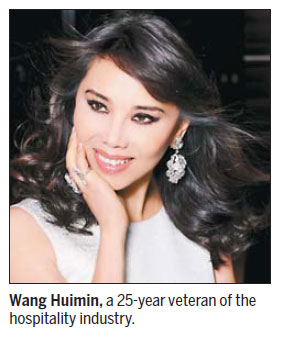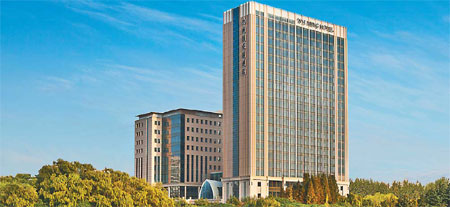Urban sanctuary
Updated: 2012-10-13 08:10
By Zhu Yile (China Daily)
|
||||||||
|
WHM Group, known for its upscale Chinese restaurants, is expanding into the hotel sector. Photos Provided to China Daily |
Amid lush greenery, the WH Ming Hotel delivers authentic Shanghainese hospitality in a refined modern setting. Zhu Yile reports.
The Shanghai-based WHM Group, known for its upscale Chinese restaurants, is expanding into the hotel sector with an exclusive five-star property on the Northeast Bund. The 188-room WH Ming hotel, named for the pinyin abbreviation of company founder Wang Huimin's name, aims to create an authentic Shanghai hospitality experience enriched with a contemporary flair.
 |
Billed as an "urban hideaway", the WH Ming stands on a sprawling 600,000-square-meter lot, a stone's throw from Huangxing Park. The hotel is designed to appeal to the senses of busy travelers and city residents looking for sanctuary in the heart of Shanghai, says Wang, a 25-year veteran of the hospitality industry.
With most five-star hotels managed by American or European companies, Wang sought with the WH Ming Hotel to create a homegrown luxury hospitality experience.
"I want to show the world that China can do it, too," she says.
"With Frank Rudis, who has rich hotel management experience and can effectively implement my vision, as general manager, the WH Ming offers the very best of East and West."
Rudis says: "Given Wang Huimin's deep understanding of the local market, I am optimistic about this distinctly Chinese luxury hotel."
At the core of the WH Ming experience is the concept of "one night, two meals", which emerged in Asia during the 1990s and encompasses a delicious dinner, revitalizing sleep and exceptional breakfast.
"It helps city dwellers recharge," says Wang. "Once they feel refreshed, they are glad to return to their fast-paced urban lifestyles."
WH Ming, she says, has re-imagined the concept for contemporary Shanghai, featuring the city's eminent cuisine and serving it both in the hotel restaurant and on request in the rooms of guests.
Guests can enjoy spa service at the hotel's Faye Spa Center. The 5,000-sq-m space covers three floors and includes 22 private spa suites equipped with a Jacuzzi.
"We have created a spa experience that can be shared in a more communal space or experienced completely in private," Wang says.
Long known for its rich restaurant portfolio, including Shanghai Min and Maison de L'Hui, WHM Group has incorporated that culinary experience into the hotel's fine selection of breakfast foods.
"It is normal that people have a deep attachment to the food their mothers cooked for them when they were children. The hotel aims to bring that warm feeling of mom's home cooking to guests," she says.
Meanwhile, interaction between the chef and guests makes for a lively atmosphere.
One of the most unique aspects of the WH Ming Hotel is its "time tunnel", a mini-museum divided into different sections representing Shanghai's history from the Qing Dynasty until present-day. 3D video presentations on the walls depict scenes from each of the periods.
Dubbed the Media Image Art Space, the time tunnel was created by Shanghai-born Chinese-American director Hu Xueyan in collaboration with Wang.
The time-travel adventure illustrates the hotel's innovative approach to luxury hospitality, says Wang.
"The tunnel is designed so that guests can eat food from the respective periods as they watch the video, to experience the culinary evolution of Shanghai," she says.
At the end of the time tunnel is a green space filled with luxuriant plants representing a bright future. A special massage chair in this section is available to guests who wish to unwind.
"It is a wonderful way to relax at the end of the journey," says Wang.
Contact the writer at zhuyile@chinadaily.com.cn.

 'Taken 2' grabs movie box office crown
'Taken 2' grabs movie box office crown
 Rihanna's 'Diamonds' tops UK pop chart
Rihanna's 'Diamonds' tops UK pop chart
 Fans get look at vintage Rolling Stones
Fans get look at vintage Rolling Stones
 Celebrities attend Power of Women event
Celebrities attend Power of Women event
 Ang Lee breaks 'every rule' to make unlikely new Life of Pi film
Ang Lee breaks 'every rule' to make unlikely new Life of Pi film
 Rihanna almost thrown out of nightclub
Rihanna almost thrown out of nightclub
 'Dark Knight' wins weekend box office
'Dark Knight' wins weekend box office
 'Total Recall' stars gather in Beverly Hills
'Total Recall' stars gather in Beverly Hills
Most Viewed
Editor's Picks

|

|

|

|

|

|
Today's Top News
Health new priority for quake zone
Xi meets US top military officer
Japan's boats driven out of Diaoyu
China mulls online shopping legislation
Bird flu death toll rises to 22
Putin appoints new ambassador to China
Japanese ships blocked from Diaoyu Islands
Inspired by Guan, more Chinese pick up golf
US Weekly

|

|







